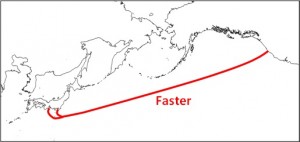According to Capacity, a consortium of six companies has launched an effort to build a new transpacific cable system, called FASTER (as if anyone would call a cable ‘SLOWER’? haha). The cable will cost some $300M, and will put six fiber pairs capable of 60Tbps between the US west coast and Japan.
The composition of the consortium tells interesting stories. From the US we have Google, which seems to care more about such infrastructure now than any of the actual network operators. From Japan we have KDDI, whose involvement will give them another leg up in their competition with NTT. From China we have both China Mobile and China Telecom, each of whom has long had ambitions for more global influence in a region (and world) suspicious of Chinese influence. From the unavoidable data nexus of Singapore we have SingTel, who likes to have a finger in every consortium that touches its region. And last we have Malaysian-based Global Transit, which is looking to supplement its capacity on Unity and keep an eye on SingTel too.
 Not on the list is any operator from India or Australia, or any of the major telecoms in the western world. Global Cloud Xchange has its own plans in the works for such a system of course. Telstra, AT&T, Verizon, Vodafone (i.e. Cable & Wireless), Sprint, and the rest are working on other things.
Not on the list is any operator from India or Australia, or any of the major telecoms in the western world. Global Cloud Xchange has its own plans in the works for such a system of course. Telstra, AT&T, Verizon, Vodafone (i.e. Cable & Wireless), Sprint, and the rest are working on other things.
The target date is apparently sometime in 2016. Of course, launching a consortium doesn’t mean the cable will actually get built, and we’ve seen more than a few such proposals vanish without a trace. Yet these six probably wouldn’t have gotten this far together if they weren’t serious about funding it, so perhaps the next transpacific wave is finally here.
Here is the original PR from NEC, which has been tapped to do the heavy lifting.
If you haven't already, please take our Reader Survey! Just 3 questions to help us better understand who is reading Telecom Ramblings so we can serve you better!
Categories: ILECs, PTTs · Undersea cables






Rob, who do you think this consortium will have lighting/managing this proposed cable system (assuming it actually happens)? I’m with you on the “we hear a lot of proposals about building by private enterprise” concept. The thing is, do any of these companies really want to become ULH/trans pacific carriers? OK I get it … this 6 strand is going to be used by …. just those six Are they all planning on sitting on the bone? Is this cable going to be connected to a POP access ? I just really don’t know what these folks are thinking of for use. If they want to wire connections to between locations …. but I doubt that GOOG needs for transit are going to be the same as other companies…. My point is, hiring a company to roll and drop the cable in the ocean is one thing. My guess is it’s going to be the same relationship as some companies that lease dark fiber… at the end of the day … we will still end up running things for them.
Google had already been an initial investor in the Unity trans-Pacific system some years ago. It’s a simple build/buy proposition for them. In 2008 a dude with long curly blond hair walked into PTC (the annual trans-Pac whole trading conference) with his team and demanded ultra-cheap capacity deals otherwise they’d go it alone. Many thought they were bluffing. Google has a small submarine team that manages this stuff.
Agree that the US POP location will be critical. If they are aggressive about the construction schedule and building a new landing station, they will probably have to land up north, likely Oregon, as the environmental controls in California are restrictive and would really delay things. My guess though is that will land in LA. The Unity system lands at Redondo Beach and FASTER has common initial investors, so I think they’l find some space for it there.
In the PR it was announced that NEC is the contractor and that they will start the build immediately with an RFS of early 2016. That means that the actual deal has either been signed, or is imminent. If it’s imminent, there’s a chance that they are playing chicken with a US initial investor (that owns a landing station). If that’s the case, you might get another announcement soon listing the additional investor together with the US landing point.
Despite Google being all over the PR, this is primarily a Chinese system with both CMI and CT investing and, apparently, with one of them heading the management committee.
Ah, the days of Erikas.
Erikas indeed :).
For the US POP, Redondo Beach would appear to be the obvious location.
Perhaps, but the feedback we get is that even new cables to existing landing stations is very difficult to get past the environmental controls nowadays.
The map above suggests the old CH-US landing at Bandon, OR or conceivably AKORN at Florence, OR.
A derivative of Google has completed an oceanfront purchase in Bandon. The new ownership is contiguous to the L3 facility and within a few 100 yards of the ATT fiber station.
Do you know the address of the L3 facility in Bandon or an intersection where it is near? Thanks